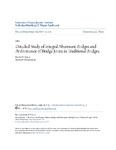Please use this identifier to cite or link to this item:
http://lib.hpu.edu.vn/handle/123456789/25185Full metadata record
| DC Field | Value | Language |
|---|---|---|
| dc.contributor.author | Quinn, Brooke H. | en_US |
| dc.contributor.author | Civjan, Scott | en_US |
| dc.date.accessioned | 2017-06-15T09:01:21Z | |
| dc.date.available | 2017-06-15T09:01:21Z | |
| dc.date.issued | 2016 | en_US |
| dc.identifier.other | HPU5160023 | en_US |
| dc.identifier.uri | https://lib.hpu.edu.vn/handle/123456789/25185 | - |
| dc.description.abstract | Integral Abutment Bridges (IABs) are jointless bridges in which the superstructure is cast monolithically with its substructure. Eliminating expansion joints from the superstructure reduces corrosion of bridge elements that typically result from leaking joints in traditional bridges. IABs have proven to be cost effective for both construction and life-cycle analysis. As a result, they are the standard single span highway bridge of choice by the majority of State Departments of Transportation (DOTs) across the country. Despite the widespread use of these bridges, there are no uniform guidelines in place. Factors such as pile orientation, design assumptions, maximum span length, skew angle, and curvature vary widely. A study of expansion joint performance was done to investigate typical problems with joints through information collected from meetings with Massachusetts DOT as well as survey results collected from DOT personnel from nine states in and around New England. Results highlight the many issues associated with expansion joints which have resulted in the preference to construct IABs whenever possible. The Vermont Agency of Transportation (VTrans) instrumented three IABs of increasing complexity for long term monitoring and analysis of their performance. The bridges include a straight bridge with 141 ft (43 m) span, a 15 degree skew bridge with 121 ft (37 m) span, and a two-span continuous curved structure with 11.25 degrees of curvature and 221 ft (68 m) total bridge length. This dissertation presents over five years of field data. Results are compared with three-dimensional finite element model predictions. Variations in response due to skew, curvature, and field conditions are addressed. The finite element models were the basis for a parametric study investigating the effect of pile orientation on IABs of varying length and skew angle. Results highlight the factors that affect optimal pile orientation to avoid pile yielding. | en_US |
| dc.format.extent | 338 p. | en_US |
| dc.format.mimetype | application/pdf | en_US |
| dc.language.iso | en | en_US |
| dc.publisher | Massachusetts Institute of Technology | en_US |
| dc.subject | Structural Engineering | en_US |
| dc.subject | Integral Abutment Bridges | en_US |
| dc.subject | Bridge Joints | en_US |
| dc.title | Detailed Study of Integral Abutment Bridges and Performance of Bridge Joints in Traditional Bridges | en_US |
| dc.type | Thesis | en_US |
| dc.size | 12,577Kb | en_US |
| dc.department | Technology | en_US |
| Appears in Collections: | Technology | |
Files in This Item:
| File | Description | Size | Format | |
|---|---|---|---|---|
| 23_Detailed_Study.pdf Restricted Access | 12.58 MB | Adobe PDF |  View/Open Request a copy |
Items in DSpace are protected by copyright, with all rights reserved, unless otherwise indicated.
